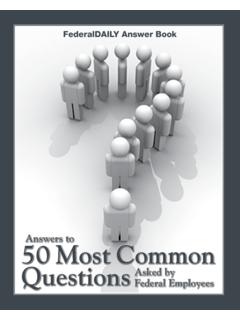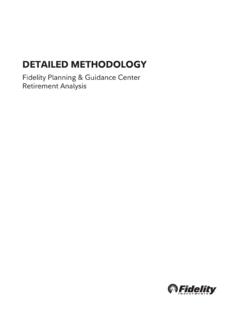Transcription of 1. Overview of FERS and Types of Retirement - 1105 Media
1 YOUR fers Retirement 1. Overview of fers and Types of Retirement The Federal Employees Retirement system ( fers ) is the newer of the two Retirement systems that cover many federal and Postal Service (USPS) employees. Most of these employees began working for the federal government or USPS after Jan. 1, 1984. Some employees covered by the Civil Service Retirement system (CSRS), the older of the two Retirement systems, voluntarily elected to transfer to fers during one of the fers open seasons in 1987 and 1998. fers is categorized as a federal government-sponsored defined benefit Retirement plan. As such, an employee who retires under fers will never outlive his or her fers basic annuity. And if the annuitant has elected a survivor annuity, the survivor annuitant will never outlive the survivor portion of the annuity. On Oct. 28, 2009, the National Defense Authorization Act (NDAA) was passed into law.
2 Among the changes to fers brought about as a result of NDAA's passage that affect current fers employees are: 1. the treatment of unused sick leave upon a fers -covered employee's Retirement ;. 2. changes in the calculation of the high-three average salary for federal employees who work in nonforeign areas such as Alaska and Hawaii; and 3. changes to the redeposit rule for those fers employees who left federal service, withdrew their fers contributions, and then subsequently returned to federal service under fers . Public Law 112-96, Section 5001, the Middle Class Tax Relief and Job Creation Act of 2012 , made two significant changes to fers . These changes took effect Jan. 1, 2013, at which time newly hired employees will have to contribute each pay date a higher portion of their after-tax salary to fers . The second change is that new members of Congress and congressional employees will also have to contribute more to fers and will accrue Retirement benefits at the same rate as regular employees.
3 In general, those employees who enter federal service as a full-time or part-time permanent employee on or after Jan. 1, 2013, will be covered under fers as Revised Annuity Employees (RAE), or fers -RAE. There are exceptions to the new Retirement coverage rule, and the date Dec. 31, 2012, is a key date for each of those exceptions. An individual will be excluded from fers -RAE coverage if any of the following exceptions apply: (1) an employee on Dec. 31, 2012, was covered under fers ; (2) an employee on Dec. 31, 2012, was performing civilian service which is creditable or potentially creditable (see below) under fers ; an example of the second exception is an employee who is covered under any of the other Retirement systems from which service credit may be transferred to fers such as CSRS or CSRS. Offset; or (3) an employee on Dec. 31, 2012, was not covered under fers and was not performing civilian service which is creditable or potentially creditable service under fers , but as of Dec.
4 31, 2012, had performed at least five years of creditable civilian service or potentially creditable service under fers , CSRS or CSRS Offset in prior years. These changes and how they affect current fers employees are discussed below. fers -covered employees hired before Jan. 1, 2013, contribute percent of their wages (using after-tax dollars) to the fers Retirement and Disability Fund. The federal government contributes the rest toward the fers annuity on behalf of an employee, and together with earnings on these contributions, a fers -covered employee will be able to retire with a guaranteed 4. YOUR fers Retirement income for the rest of his or her life. Each month a fers annuitant receives (as part of the annuity) a portion of what had been contributed. Since these contributions were previously taxed, the annuitant receives these contributions back tax- free. Employees who were covered by CSRS (with at least five years of service), and who voluntarily transferred to fers during one of the two fers open seasons in 1987 and 1998, will receive two components to their Retirement annuities.
5 One portion comes from CSRS and the other portion from fers . fers -covered employees also contribute percent of the first $113,700 of their wages (during 2013) to Social Security (the Federal Insurance Contributions Act, or FICA tax). (During 2011 and 2012, the employee portion of the FICA tax was reduced to percent.) As such, fers employees are eligible to receive Social Security Retirement benefits as early as age 62. They also contribute percent of their wages to Medicare Part A (hospital insurance), and are eligible to receive Medicare Part A benefits starting the month they become age 65. They also have the option of electing Medicare Part B (medical insurance) either at age 65 or when they retire whichever is later. Finally, a major portion of fers is the Thrift Savings Plan (TSP). During 2013 fers -covered employees may contribute as much as $17,500 of their basic pay to the TSP. In addition, the government automatically contributes 1 percent of an employee's basic pay and up to 4 percent of the employee's basic pay in matching contributions, depending on the amount of the employee's contribution.
6 Those employees who will be at least age 50 as of Dec. 31, 2013, are eligible to contribute during 2013 an additional $5,500 ( catch-up . contributions) of their basic pay to the TSP (with no agency matching). Employees need to verify their coverage by checking their Standard Form (SF) 50, which is in their personnel files. Please note Block 30 of SF-50, which is labeled Retirement Plan. Table 1 indicates that a fers -covered employee hired before Jan. 1, 2013, should have a code K, L, M or N in Block 30. A fers -covered employee hired after Dec. 31, 2012, or rehired after Dec. 31, 2012, and with less than five years of prior creditable service should have a code KR, LR, MR or NR in Block 30. Employees need to verify their codes to make sure that they are in the correct system . Table 1. Retirement Plans Retirement Plan Commonly Called SF-50 (Box 30) Code . Civil Service Retirement system CSRS Code 1 or 6.
7 Civil Service Retirement system CSRS Offset Code C or E. and Social Security Social Security Only FICA Code 2. Federal Employees fers Code K, L, M, or N. Retirement system Federal Employees Retirement fers -RAE Code KR, LR, MR, or NR. system - Revised Annuity Employees (RAE). 5. YOUR fers Retirement Table 2. Types of fers Retirements Type of Minimum Minimum Special Requirements Retirement Age Service (Years). Optional No Age 62 5 None Reduction 60 20 None MRA* 30 None (MRA + 10) MRA 10 5 Years Civilian Service. Reduction 5/12 of 1% for each month (5% per year) employee is under age 62. Annuity commencing date can be postponed to eliminate all or a portion of the age reduction Optional Early Out 50 20 Optional Early Out. Major RIF, transfer function or Any Age 25 reorganization. Involuntary Discontinued 50 20 Discontinued Service. Your separation must be involuntary Service Any Age 25 and not removal for misconduct or delinquency.
8 Disability Any Age 18 months Civilian Disability. You must be disabled for useful and efficient Service service in your current position and any other vacant position at the same grade or pay level within your commuting area and current agency for which you are qualified. Law Enforcement Officer, 50 20 Complete 20 years as Law Enforcement Officer, or Firefighter Any Age 25 Firefighter or combination. Minimum, 3 years in primary position. Air Traffic Controller 50 20 Complete 20 years as Air Traffic Controller. Any Age 25. Deferred MRA 10 Performed at least 10 years of service. Reduction 5/12 of 1% for each month (5% per year) employee is under age 62. 62 5 years None Civilian Service 60 20 None MRA 30 None Mandatory 57 20 Law Enforcement 57 20 Firefighter 56 20 Air Traffic Controller 6.







